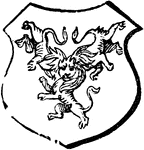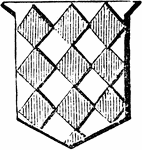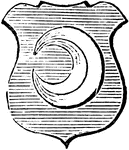
Increscent
"Azure, a moon increscent argent. INCRESCENT. The new moon, with her horns turned towards the dexter…

Chief Indented
"Or, a chief gules, indented. INDENTED. A serrated figure, much smaller than the dancette." -Hall, 1862
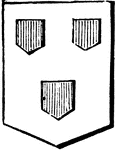
Inescutcheons
"Argent, three inescutcheons gules. INESCUTCHEON. The name given to small escutcheons forming a bearing…
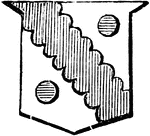
Bend Invected
"Argent, a bend gules, invected between two hurts. INVECTED. A line formed with small semicircles, with…

Knights-Banneret
"KNIGHTS-BANNERET. This ancient and honourable order has become extinct. It obtained the title of banneret…

Knight and Baronet of King James I
"KNIGHT AND BARONET. A degree of honour next to a baron, created by King James I. to induce the English…

Knight and Baronet of Nova Scotia
"KNIGHT AND BARONET OF NOVA SCOTIA. A new creation during the reign of George I. to induce capitalists…
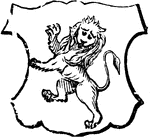
Lion Rampant Gardant
"Lion rampant gardant. RAMPANT. Any beast in a fighting attitude." GARDANT. Facing foward. -Hall, 1862
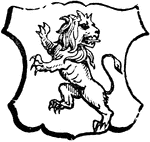
Lion Rampant Regardant
"Lion rampant regardant. RAMPANT. Any beast in a fighting attitude. REGARDANT. An animal looking towards…
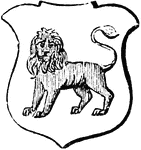
Lion Statant Gardant
"Lion statant gardant. STATANT. An animal standing still with all its legs on the ground." GARDANT.…

Lion Couchant
"Lion couchant. COUCHANT. The French word for lying down with the breast towards the earth, and the…

Lion Dormant
"Lion dormant. DORMANT. The French word for sleeping, used to denote the posture of a lion, or any other…

Lioncels Combatant
"Lioncels combatant. LIONCELS. Two or more lions. COMBATANT. A French word for fighting." -Hall, 1862
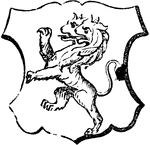
Lion Rampant Double-Headed
"Lion rampant double-headed. RAMPANT. Any beast in a fighting attitude." -Hall, 1862

Stag Lodged
"LODGED. A stag sitting on the ground with its head erect, is said to be lodged." -Hall, 1862

Lozenge
"Or, a lozenge vert. LOZENGE. An angular figure, known as diamond-shaped, to distinguish it from the…

Martlet
"Argent, a martlet, gules. MARTLET. An imaginary bird said to be without legs; it is used both as a…

Mascle
"Argent, a mascle, vert. MASCLE. An open lozenge-shaped figure, one of the subordinate ordinaries."…

Millrind
"Argent, a millrind, gules. MILLRIND. The iron placed in the centre of a grindstone to protect the hole…

Mitre
"MITRE. A sacerdotal ornament for the head, worn by Roman Catholic archbishops and bishops on solemn…

Mitre
"Mitre. A sacerdotal ornament for the head, worn by Roman Catholic archbishops and bishops on solemn…

Mound
"MOUND. A globe encircled with a band and surmounted with a cross; it is an ensign of royalty, signifying…

Mullet
"Azure, a mullet or. MULLET. From the French word molette, the rowel of a spur: it is generally drawn…

Naiant
"Argent, a salmon proper, naiant, its head towards the sinister side of the shield. NAIANT. A French…

Lion Naissant
"Or, from the midst of a fess, gules, a lion rampant naissant. NAISSANT. A French word signifying coming…
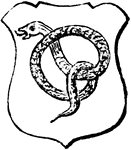
Serpent Nowed Proper
"Argent, a serpent nowed proper. NOWED. This word signifies tied or knotted, and is applied to serpents,…
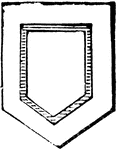
Orle
"ORLE. A subordinate ordinary composed of double lines going round the shield at some distance from…

Bend Over All
"Quarterly or and gules, over all a bend vair. OVER ALL. This expression describes a figure borne over…
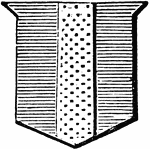
Pale
"Azure, a pale or. PALE. One of the honourable ordinaries formed by two perpendicular lines drawn from…

Pall
"Azure, on a pall argent, four crosses fitchy sable, in chief a cross pattee of the second. PALL. A…

Paly
"Paly of four, argent and gules. PALY. A field divided by perpendicular lines into several equal parts…

Parted Per Pale and Per Bend Sinister
"PARTED PER PALE AND PER BEND SINISTER Counterchanged, or and gules. PARTY or PARTED signifies divided,…

Parted Per Pale and Per Chevron
"PARTED PER PALE AND PER CHEVRON Gules and or, counter changed. PARTY or PARTED signifies divided, and…

Party Per Fess Engrailed
"Party per fess, engrailed, argent and gules. PARTY PER FESS. A shield parted in the centre by an horizontal…

Party Per Pale
"Parted per pale, gules and argent. PARTY PER PALE. This signifies a shield parted by a perpendicular…
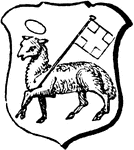
Paschal Lamb
"Argent, a lamb passant, carrying a banner charged with a cross. PASCHAL LAMB, or HOLY LAMB." -Hall,…

Pennons
"PENNONS. Small flags borne at the end of a lance of an esquire or gentleman bearing his paternal arms.…

Pheon
"Argent, a pheon proper. PHEON. A missile instrument with a barbed head, thrown from a cross bow." -Hall,…

Mulllet Pierced
"Argent, a mullet pierced, sable, on a chief azure, three mullets pierced, of the first. PIERCED OR…

Pile
"Argent, a pile, purpure. PILE. An angular figure like a wedge, formed by lines running from the dexter…

Swords in Pile
"Argent, three swords in pile, their points towards the base. IN PILE. Arms or other charges that are…

Pommelled
"POMMELLED. The pommel of the sword is the round ball or knob at the end of the hilt of a sword." -Hall,…

Portcullis
"PORTCULLIS. A grating suspended by chains, used to defend the entrance to a castle." -Hall, 1862

Potent
"Argent and azure, potent and counter potent. Some armorists call counter potent vary cuppy. POTENT.…

Quartered
"QUARTERED. A shield divided into four equal parts by a cross is said to be quartered. The quarter occupying…

Radient
"Azure, a pale, or, radient. RADIENT. Any charge having rays or beams about it." -Hall, 1862
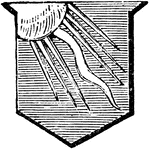
Ray of Sun
"Azure, a ray of the sun issuing out of the dexter corner of the escutcheon. The lines on each side…
Sceptre with the Dove
"The sceptre with the dove is of gold, three feet seven inches long; the circumference of the handle…
Sceptre with the Cross
"The royal Sceptre with the Cross is of gold; the handle is plain, and the upper part wreathed; it is…





